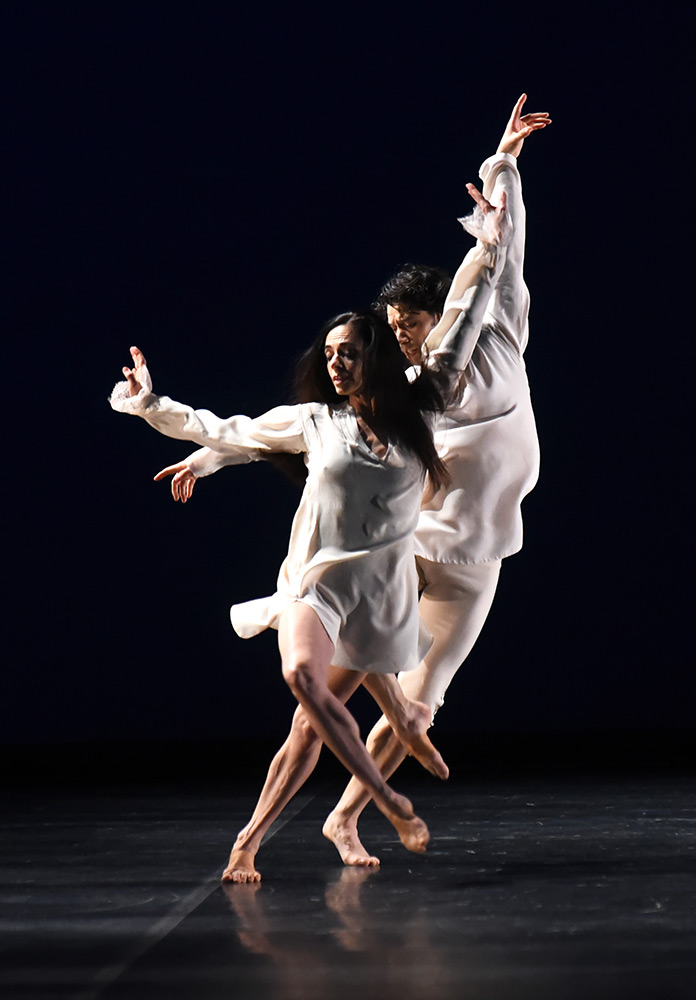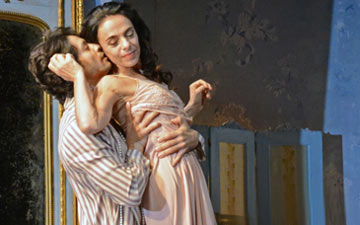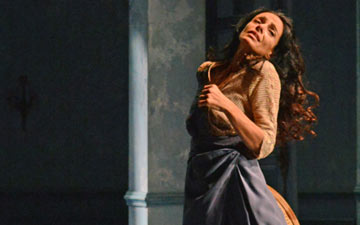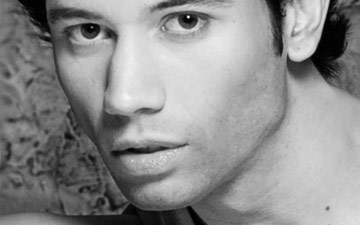
© Nicolay Krusser. (Click image for larger version)
Alessandra Ferri, Herman Cornejo and Bruce Levingston
TRIO ConcertDance with works by Russell Maliphant, Demis Volpi, Fang-Yi Sheu, Herman Cornejo, Wayne McGregor and Angelin Preljocaj
★★★★✰
London, Linbury Theatre
20 January 2019, matinee
www.roh.org.uk
The afternoon performance of TRIO reminded of those old-fashioned parlour soirées where invited guests sit back, relax, and enjoy some pleasant quality artistry. And this is just what this programme offered with its intimate potpourri of six short dances and seven musical interludes performed by a trio of talented performers – Alessandra Ferri and Herman Cornejo, accompanied by pianist Bruce Levingston. A harmonious blending of music and dance, it proved seventy-five minutes of non-stop bliss!
The performance was held in the newly furbished Linbury Theatre at the Royal Opera House, where one descends down and down into the bowels of the earth, at any moment expecting to see a Crossrail train speed by. Finally, seated in the auditorium, the chatter soon turned to hush as the lighting cut out to slowly rise with today’s fashionable gloom, revealing a pianist at a grand piano – Bruce Levingston, with whom I am going to start, for it is he who seamlessly sews this programme together. His playing throughout was superb – a classy piano recital worthy of Wigmore Hall.
As a leading figure in contemporary classical music specialising in music by Philip Glass, Levingston collaborated with Ferri on this programme about three years ago. They choose the music together and organised it so that, not only did he accompany the two dancers, but he also played solo works while they caught their breath and changed costumes. The result was that there was no break in the performance – it flowed effortlessly, and his solos of composers Ligeti, Scarlatti, Satie, Bach, Mozart as well as Glass, kept the audience’s concentrated attention. Sitting just four rows from him, it was fascinating to watch his fingers flying over the keys – especially in the Glass pieces where those fingers speedily trilled the keys like petit batterie on dancers’ legs. Throughout, Levingston’s sensitive playing complemented the movements of the two dancers – his right hand lightly but firmly expressing the direction and liquidity of the dance, while his left securely supported with strength and harmony.
As if emulating the colour of the piano keys, the dancers performed in black see-through tights and tops for the most part. The dark costumes together with low lighting must have made it hard for those sitting further away to see the details of both the steps and the dancers’ physiques clearly.

© Roberto Ricci. (Click image for larger version)
There are a few dancers who are able to command the stage whether dancing or just standing still. Nureyev was the most obvious – all eyes immediately were drawn to him when he was on stage. Sylvie Guillem was another whose every move was compulsive watching. And in TRIO, Alessandra Ferri revealed that she too still possesses that same mesmerising power in everything she does, whether coiling herself around her partner or just walking slowly but deliberately with tautly pointed feet, towards the audience.
As principal ballerina at The Royal Ballet, La Scala Theatre Ballet and American Ballet Theatre, Alessandra Ferri was renowned for her outstanding ethereality and dramatic characterisation. In 2007 she decided to retire from the stage to concentrate on family life back in her homeland of Italy. But the pull of the dance was instilled in her and after six years she succumbed. Today aged 55, Ferri talks of her return to the dance world as ‘living in the moment’, and that today, she dances out of pure passion rather than trying to impress for future roles. She indeed has the required ingredients – a petite, toned sinewy body, a strong, lithe and exacting technique and an obvious conviction in every move that she makes.
Her partner for this programme is Argentinian born Herman Cornejo, a principal dancer at American Ballet Theatre. Tall, muscular, handsome and youthful – 20 years younger than Ferri – he is an excellent partner, anticipating her every move, lifting and placing her with great care as though she were a precious icon. His dancing comes from the pure simplicity of his movement rather than from reliance on the super-tricks of today’s male dancers. In his solo, Momentum, which he choreographed to music by Glass, he showed, now freed from the closeness of partnering, more of his ability to leap and travel, which he did most elegantly.
There is a chemistry between the two dancers which brought out aspects of tenderness, solicitude as well as sensuality in their intimacy. Entwined on the floor as the first slice of light emerges for Flair, choreographed by Demis Volpi, the couple come to life at snail’s pace to begin a series of port de bras as Ligeti’s pulsating music guides them repetitiously. The work feels like an anatomical dissection of ballet technique with its poses, balances and lifts, performed by the couple with beautiful line. Ferri looks at Cornejo occasionally as if possessing an inner secret, but there is no outward emotion.

© Roberto Ricci. (Click image for larger version)
Wayne McGregor’s choreography is usually recognised for its speedy push, pull, rip-open, breath-taking moments, and moves often at odds with classicism. But here in Witness, he revealed an almost slow-motion view of those mechanical actions – fluid lines where every action of the whole body could be seen and diagnosed. Cornejo bends to protect Ferri, regularly nuzzling her neck, and each time they separate, he is always ready to turn and cling, grasping an arm or body to support her. It was a very intimate piece.
Ferri’s solo was Senza Tempo by Fang-Yi Sheu to music by Bach. Silhouetted at the back of the stage, standing stock-still for some time, she finally, very, deliberately, walks forward to the front in bare feet and executes an elegant port de bras. After long physical slow-motioned moves, she ends the piece with a quizzical look as if to say, “I did it.”
Perhaps the most beautiful work of the afternoon was Russell Maliphant’s Entwine – to yet another Glass work, again exquisitely played by Levingston. It was a ribbon of non-stop beautiful poetic movement – showing off Ferri’s supple and malleable body and strong technique and her complete trust that Cornejo would catch and hold her. Shafts of rippling waves lit the floor, and she is swirled around by him as though she were weightless. At the end, they cup each other’s heads in the palms of their hands.
The finale brought light both practically and metaphorically – white shirts and a sunlit stage and some ‘ooh’ moments. In a scene from Le Parc by Angelin Preljocaj, there is some very graphic sexy foreplay from the couple, especially from Ferri, before she flings her arms around Cornejo’s neck and kisses him full on the lips. Then comes the flying-kiss ‘tingle’ moment for the audience. Cornejo begins to turn slowly and, as Ferri clings on to his neck, her bare feet come slowly off the ground, first in demi-pointe, then pointe until he speeds up, arms out to the side, and she is flying at 45’ like a fairground swing. They continue to twirl and twirl, all the time lip-locked. It is a remarkable – and a great ending – to a show.
Most contemporary pieces today seem to carry a standard label that permits no joy, no smiling, just strained expressions of passion and desperate love. This was true for TRIO also which relied on the piano to bring emotional colouring to the afternoon. Despite this, the strong message that came from this short, highly concentrated show was that, when expertly performed, music and dance indeed unify in one glorious whole, confirming what George Balanchine said: “See the music, hear the dance.”

















Glorious review for a “glorious whoel.” Brava!